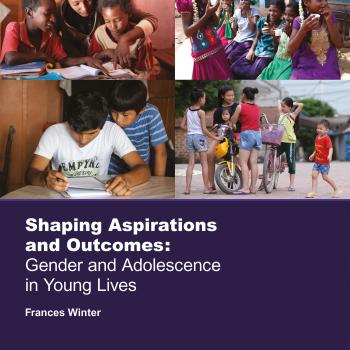
This report explores how children’s lives change during adolescence and the difference that gender inequalities and gender norms make to their pathways.
It asks three questions:
What difference does gender make to adolescents’ aspirations and outcomes? How and when do gender inequalities emerge and in which areas of adolescents’ lives? Are there windows of opportunity or particular kinds of investment that are likely to support girls and boys to reach their full potential?Our findings include:
Gender differences and inequalities in aspirations and learning outcomes become increasingly evident from early adolescence. However, gender inequalities do not always favour boys, and the impact of gender has to be understood in conjunction with the effects of poverty and other forms of socio-economic inequality. Adolescents experience violence and bullying in several different environments, with girls and boys experiencing very different patterns of violence. Girls are much more likely than boys to marry and have children before the age of 19, and marriage and parenthood has a large effect on their educational opportunities, caring responsibilities and mobility. Gender inequalities in parents’ aspirations for their children’s education were first evident when children were as young as age 8. These disparities were reflected in girls’ and boys’ aspirations for themselves at the age of 12 and in their learning outcomes and achievement by the age of 15. After puberty, social norms and expected behaviours play a greater role in young people’s lives: for example, girls’ movement may be restricted, or boys are expected to contribute significantly to family income.Young Lives findings indicate two windows of opportunity for policy intervention: middle childhood to early adolescence (which often coincides with puberty and the transition from primary to secondary school) and the period when girls come under pressure to marry. However, these ‘windows’ should be treated with caution. The underlying drivers of change for disadvantaged adolescents are effective education, job and economic opportunities to look forward to, robust social protection arrangements which improve the chances of their hopes being realised, and protection from violence. Girls and boys also need information, guidance, and advice, together with further opportunities if things do not work out as they had hoped.

This report explores how children’s lives change during adolescence and the difference that gender inequalities and gender norms make to their pathways.
It asks three questions:
What difference does gender make to adolescents’ aspirations and outcomes? How and when do gender inequalities emerge and in which areas of adolescents’ lives? Are there windows of opportunity or particular kinds of investment that are likely to support girls and boys to reach their full potential?Our findings include:
Gender differences and inequalities in aspirations and learning outcomes become increasingly evident from early adolescence. However, gender inequalities do not always favour boys, and the impact of gender has to be understood in conjunction with the effects of poverty and other forms of socio-economic inequality. Adolescents experience violence and bullying in several different environments, with girls and boys experiencing very different patterns of violence. Girls are much more likely than boys to marry and have children before the age of 19, and marriage and parenthood has a large effect on their educational opportunities, caring responsibilities and mobility. Gender inequalities in parents’ aspirations for their children’s education were first evident when children were as young as age 8. These disparities were reflected in girls’ and boys’ aspirations for themselves at the age of 12 and in their learning outcomes and achievement by the age of 15. After puberty, social norms and expected behaviours play a greater role in young people’s lives: for example, girls’ movement may be restricted, or boys are expected to contribute significantly to family income.Young Lives findings indicate two windows of opportunity for policy intervention: middle childhood to early adolescence (which often coincides with puberty and the transition from primary to secondary school) and the period when girls come under pressure to marry. However, these ‘windows’ should be treated with caution. The underlying drivers of change for disadvantaged adolescents are effective education, job and economic opportunities to look forward to, robust social protection arrangements which improve the chances of their hopes being realised, and protection from violence. Girls and boys also need information, guidance, and advice, together with further opportunities if things do not work out as they had hoped.

